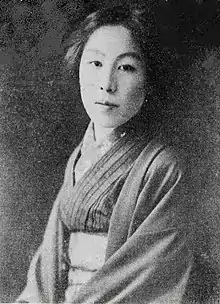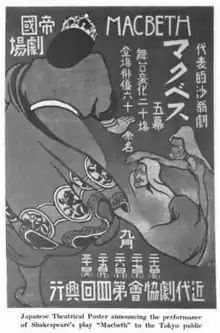Uraji Yamakawa
Uraji Yamakawa (山川 浦路, Yamakawa Uraji, 15 November 1885 – 30 November 1947) was a Japanese actress, also credited as Ura Mita.
Uraji Yamakawa | |
|---|---|
山川 浦 路 | |
 Yamakawa in 1919 | |
| Born | Uraji Yamakawa / 山川 浦 路 15 November 1885 |
| Died | 30 November 1947 (aged 62) |
| Other names | Ura Mita |
| Occupation | Actress |
| Spouse | Sōjin Kamiyama |
| Children | 1 |
Career

In 1912, she and her actor husband were co-founders of the Modern Theatre Society (Kindaigeki Kyokai) in Tokyo, formed to bring new Western works to Japanese audiences.[1][2] In 1914, Yamakawa was considered one of "the foremost interpreters of roles in Western translations" among Japanese actresses.[3][4] Among her notable roles were Henrik Ibsen's Hedda Gabler,[5] Gretchen in Goethe's Faust,[3] and Lady Macbeth, in which role she gave "a most remarkably untraditional sleep-walking scene".[6] The Modern Theatre Society ended in 1919, when the founders moved to the United States.[1][7]
She had small roles in two films during her time in America: The Devil Dancer (1927, now lost; a silent film directed by Fred Niblo) and Wu Li Chang (1930, a Spanish-language production).[8]
Personal life
Uraji Yamakawa was married to fellow Japanese actor Sōjin Kamiyama; they lived in California while Sōjin was appearing in American films.[9] After they separated, Yamakawa took bit parts, sold makeup, and cared for her adult son, Edward, who had tuberculosis. During this period, she was friends with novelist Toshiko Tamura.[10] However, during World War II she was relocated along with other Japanese-Americans, while her son was not sent together because of his illness (his subsequent fate is unknown). Yamakawa died in 1947, aged 62 years.
References
- Ryunosuke Akutagawa, Rashomon and Seventeen Other Stories (Penguin 2006): note 32. ISBN 9781101503096
- "Japanese Take up the Task of Westernizing Eastern Stage" Philadelphia Inquirer (June 29, 1913): 14. via Newspapers.com

- Z. Kincaid, "Leading Actresses of Japan" The Theatre (July 1914): 31.
- Isma Dooly, "A Japanese Woman will Star in Drama" Atlanta Constitution (May 19, 1912): c11. via ProQuest
- Henrik Ibsen repertoire database, National Library of Norway.
- Eloise Roorbach, "Macbeth Acted in Japan" Theatre Magazine (October 1916): 290.
- "Japanese See Magda Presented in their Tongue" Honolulu Advertiser (March 21, 1919): 6. via Newspapers.com

- The American Film Institute Catalog of Motion Pictures Produced in the United States, Part 1 (University of California Press 1997): 184. ISBN 9780520209695
- "Eminent Actors from Far Japan Now in U. S." Evening News (July 23, 1919): 3. via Newspapers.com

- Anne E. Sokolsky, From New Woman Writer to Socialist: The Life and Selected Writings of Tamura Toshiko from 1936–1938 (BRILL 2015): 20-21. ISBN 9789004291072